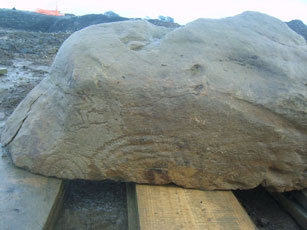Megalithic art discovery at Lismullin souterrain
|
|
On
Thursday 29th November, while lifting the capstone off the main chamber
of the souterrain at Lismullin, archaeologists discovered decoration
carved into the side of the stone. The art mainly consists of a double
row of zigzags or chevrons, half a series of concentric circles and
what appears to be a nest of arcs. The stone is a boulder that had been
split in antiquity and so only a portion of the art survives on the
stone.
The find was immediately reported to the National Monuments
section of the Department of the Environment, Heritage and Local
Government.
Preliminary
interpretation on site was that the stone was part of a megalith
originally used as a kerbstone on a Neolithic passage tomb.
|
|

Lismullin Souterrain Capstone
|
|
The
early medieval builders of the souterrain reused a large boulder from
an earlier monument, probably a kerbstone from a Neolithic passage
tomb. The boulder was split before incorporation into the souterrain
and the decoration would not have been visible inside the souterrain.
In one of the attached photos you can see what our first glimpse of the
capstone looked like - the art was hidden underneath a clay capping
that would have been used to waterproof the chamber below.
Dr
Muiris O'Sullivan (University College Dublin), who studied the
megaliths at Knowth and recently published the excavations of the Mound
of the Hostages, has confirmed that it is indeed megalithic art. Nearby
examples of passage tombs with megalithic art include the Mound of the
Hostages on the Hill of Tara and a tomb at Ardmulchan.
Dr
Blaze O'Connor, (PhD prehistoric art) who reported on the Louth
examples, has commented that the Lismullin megalith has strong formal
parallels to the Tateetra art.
Professor
George Eogan, who excavated Knowth, has concurred with the
interpretation that the boulder is a reused passage tomb kerbstone. The
'quarrying' of former monuments for construction stone for the building
of souterrains is not unusual, including decorated stones.
There
is a photograph of such a stone in souterrain on the cover of NRA
Archaeology Monograph No. 2, published 2005, which was found in a
souterrain excavated at Newtownbalregan during the archaeological works
on the M1 Dundalk Western Bypass (see Archaeological Publications
www.nra.ie). Another example of megalithic art incorporated into a
souterrain was found at Tateetra west of Dundalk, also on the M1
Dundalk Western Bypass.
|